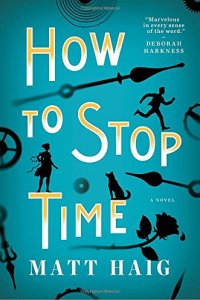Paul Di Filippo reviews How to Stop Time by Matt Haig
How to Stop Time, by Matt Haig (Viking 978-0-525-52287-4, $26, 336pp, hardcover) February 2018
 I am not quite sure how I managed to be ignorant of Matt’s Haig’s work prior to this moment, especially since he has produced twelve prior novels–the first appearing in 2004, and one currently optioned for film–and a non-fiction bestseller. I can only blame the incredible and overwhelming plethora of interesting books being produced these days. Gone is the era when even a dedicated reader could keep up with everything.
I am not quite sure how I managed to be ignorant of Matt’s Haig’s work prior to this moment, especially since he has produced twelve prior novels–the first appearing in 2004, and one currently optioned for film–and a non-fiction bestseller. I can only blame the incredible and overwhelming plethora of interesting books being produced these days. Gone is the era when even a dedicated reader could keep up with everything.
But, happily, with the publication of How to Stop Time, he is now on my radar, and it’s never too late to read backwards down the years, every fan his or her own Merlin.
The first thing to note about Haig’s newest is that it occupies the genre of speculative tales about immortals or “merely” long-lived individuals, specifically those in hiding amongst us mayflies. (See the entry in The Science Fiction Encyclopedia for an exhaustive list and analysis of the trope.) This is a very potent “power chord,” but one that has been explored quite extensively. Can Haig make it new? I think the answer is yes.
The time of the story is our familiar present day; our hero is one Tom Hazard, born in the year 1581 and consequently over four- hundred-years old in the twenty-first century. His bodily state is dubbed “anageria.” He will age only one physiologic year for every fifteen calendar years, thus granting him a lifetime of a millennium or so. He narrates his own tale, and we are about to take a deep dive into his troubled and deteriorating psyche and insufferable condition, delivered in crisp, arresting, colorful imagery, laden with much earned pathos. His tale brings to mind a couple of classics in this vein, Robert Silverberg’s Dying Inside and Olaf Stapledon’s Odd John. In fact, one can observe that the trope of the person who is blessed with longevity due to genetics, and not due to technological tampering, overlays that of the mutant who possesses some other talent–telepathy or teleportation or some other wild skill. It’s always the story of being alienated from the common run of mankind, of a poisoned gift, and, with luck, eventual redemption and acceptance.
We quickly come to learn that this is indeed Tom’s status, as his narrative skips around among the eras of his long lifetime. We witness his youngest years, when his alien condition got his mother killed for witchcraft. We see his struggles to survive alone in Shakespeare’s London (vividly rendered), and his first love affair with a young woman named Rose. We observe his frantic search for answers to his condition during the reign of Victoria, and how this quest brought him into contact with the Albatross Society, the secret group of the long-lived formed by Hendrich Pietersen, the oldest albatross or “alba,” who maintains an improbable joie de vivre atop a ruthless determination to survive.
“The poor man has never had a hot dog before. We must take him to Coney Island. They have the best in the whole city…”
“Is it food?” I asked.
“Yes.” He laughed, drily. “It’s a sausage. A special sausage. A Dachshund sausage. A special little frankfurter. It’s heaven in a bun. It’s what all of civilisation has been heading towards … If I’d have known, growing up in Flanders, that one day I would get to taste a hot dog. Well!”
Hendrich enforces secrecy upon all the albas, making them assume regular fresh identities when their agelessness raises suspicions. (And he exacts a price for his help.) Currently he has installed Tom as a secondary-school history teacher in London. This realtime part of his tale–by contrast to his long backstory, compactified into just a few weeks–is the core of the novel, as Tom struggles with finding a reason to continue living. (One motivation is the search for his equally long-lived daughter, Marion, whom he lost in the Elizabethean era.) Since love is forbidden to the albas, by direction of Hendrich, his encounters with attractive and sympathetic fellow teacher Camille raise perilous feelings. As does the naive ignorance of his students.
Haig excels at conveying the weight of the years on mere human mentality–a famous riff from Heinlein’s Time Enough for Love, a book thematically allied to this one.
Psychologically, I mean. You kind of ran out. There wasn’t enough self to keep going. You grew too bored of your own mind. Of the way life repeated itself. How, after a while, there wasn’t a smile or gesture that you hadn’t seen before. There wasn’t a change in the world order that didn’t echo other changes in the world order. And the news stopped being new. The very word “news” became a joke. It was all just a cycle. A slowly rotating downward one. And your tolerance for human beings, making the same mistakes over and over and over and over again, began to fade. It was like being stuck in the same song, with a chorus you had once liked but now made you want to rip your ears off.
Haig’s prose benefits from his having written for a YA audience. While his language and syntax are assuredly “mature” in this instance, it reveals a kind of directness and concern for clarity that more mannered, fussy and self-absorbed “adult” styles do not share. In this sense, it conveys Tom Hazard’s consciousness quite well: he has passed from a childish mind through adulthood and back to the borders of a kind of wise second childhood which has not quite gelled.
It is strange how close the past is, even when you imagine it to be so far away. Strange how it can just jump out of a sentence and hit you. Strange how every object or word can house a ghost.
The past is not one separate place. It is many, many places, and they are always ready to rise into the present. One minute it is the 1590s, the next it is the 1920s. And it is all related. It is all the accumulation of time. It builds up and builds up and can catch you violently off guard at any moment. The past resides inside the present, repeating, hiccupping, reminding you of all the stuff that no longer is. It bleeds out from road signs and plaques on park benches and songs and surnames and faces and the covers of books. Sometimes just the sight of a tree or a sunset can smack you with the power of every tree or sunset you have ever seen and there is no way to protect yourself. There is no possible way of living in a world without books or trees or sunsets. There just isn’t.
But in the stirring and exciting and very satisfying climax, all the discordant parts of Tom’s psyche do resolve and cohere, and he exits the book into a saner, safer, happier world well won, proving that he is not apart from humanity, but merely an outlier on the capabilities and frustrations, rewards and challenges that all we captives of time must share.






